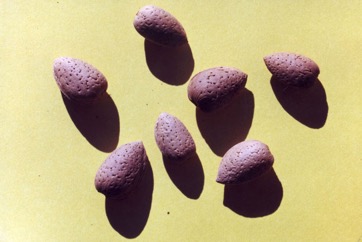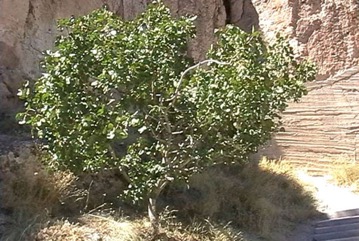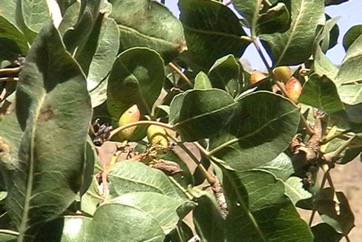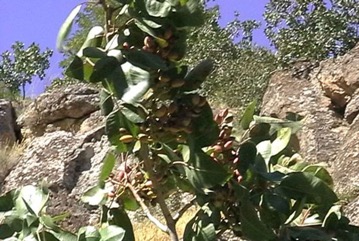Pistachio nut

It is a warm temperate and Mediterranean climate plant. It suits hot dry places. They do well in light calcareous soils. They need fertile, well-drained soils. They can tolerate drought. Winters need to be cool to break bud dormancy. Trees need 600 to 1,500 hours of chilling below 6°C. Trees do not do well in areas with high humidity. They grow in places with temperatures from -10°C in the winter to 40°C in the summer. In western Asia they grow to 1500 m altitude. They do best with a pH of 7-7.8. It suits hardiness zones 8-10.
Also known as:
Kalliki fistiga, Pesta, Pista, Pista-thee-bin, Pistache, Pistachero, Snow lotus seed, Xue lian zi
Edible Portion
- Fruit, Nuts, Seeds, Flavouring, Spice
Where does Pistachio nut grow?
Found in: Afghanistan, Africa, Asia, Australia, Azerbaijan, Bangladesh, Caucasus, Central Asia, China, Cyprus, Europe, France, Georgia, Greece, India, Iran, Iraq, Israel, Italy, Kazakhstan, Kyrgyzstan, Lebanon, Mediterranean, Mexico, Myanmar, North Africa, North America, Pacific, Pakistan, Palestine, Papua New Guinea, PNG, Philippines, SE Asia, Serbia, South Africa, Southern Africa, Spain, Syria, Tajikistan, Tunisia, Turkey, Turkmenistan, Uzbekistan, United States
Notes: It forms hybrids with Pistacia khinjuk and Pistacia atlantica.
Growing Pistachio nut
Cultivation: Mostly grown from seed. The seed should be presoaked in alkalized water or for 3-4 days in warm water before sowing. Germination can be slow and irregular. Cuttings of half ripe wood from young trees can be used. Trees can be grown by layering. Because male and female flowers occur on separate trees both male and female trees must be present. One male tree to 5 female trees is suitable. It is possible to graft a male branch onto a female tree. The pollen is carried by wind. The flowers are small and green in clusters in the axils of leaves. The nuts are normally knocked off the trees then harvested off the ground.
Edible Uses: The nuts are eaten after roasting and salting. They can be eaten raw. They are used in confectionery, ice cream, cakes, pies, soups etc. An edible oil can be produced from the seed. The fruits can be used for marmalade. Caution: It contains urushiol that can cause allergic reactions in some people.
Production: It is slow growing. Seedlings take 8 years to bear. Budded and grafted trees can bear in 4 years. Peak production is reached after about 20 years. Trees can live for centuries under suitable conditions. The fruit take several months to mature.
Nutrition Info
per 100g edible portion| Edible Part | Energy (kcal) | Protein (g) | Iron (mg) | Vitamin A (ug) | Vitamin c (mg) | Zinc (mg) | % Water |
|---|---|---|---|---|---|---|---|
| Seed | 622 | 17.6 | 7.3 | 55 | 7 | 2.2 | 5.9 |
Pistachio nut Photos




References
Arora, R. K., 2014, Diversity in Underutilized Plant Species - An Asia-Pacific Perspective. Bioversity International. p 96
Bianchini, F., Corbetta, F., and Pistoia, M., 1975, Fruits of the Earth. Cassell. p 198
Blamey, M and Grey-Wilson, C., 2005, Wild flowers of the Mediterranean. A & C Black London. p 127
Bodkin, F., 1991, Encyclopedia Botanica. Cornstalk publishing, p 805
Bremness, L., 1994, Herbs. Collins Eyewitness Handbooks. Harper Collins. p 74
Cheifetz, A., (ed), 1999, 500 popular vegetables, herbs, fruits and nuts for Australian Gardeners. Random House p 220
Cundall, P., (ed.), 2004, Gardening Australia: flora: the gardener's bible. ABC Books. p 1053
Ertug, F, Yenen Bitkiler. Resimli Türkiye Florası -I- Flora of Turkey - Ethnobotany supplement
Facciola, S., 1998, Cornucopia 2: a Source Book of Edible Plants. Kampong Publications, p 172
FAO, 1995, Edible Nuts. Non Wood Forest Products 5.
Flora of Pakistan. www.eFloras.org
Flowerdew, B., 2000, Complete Fruit Book. Kyle Cathie Ltd., London. p 202
French, B.R., 1986, Food Plants of Papua New Guinea, A Compendium. Asia Pacific Science Foundation p 194
Glowinski, L., 1999, The Complete Book of Fruit Growing in Australia. Lothian. p 106
Haq, N., Anthony, K., Sarwar, M., and Ahmad, Z. (eds.), 1998, Underutilized Crops of Pakistan. Plant Genetic Resources Institute. p 13
Hedrick, U.P., 1919, (Ed.), Sturtevant's edible plants of the world. p 502
Hibbert, M., 2002, The Aussie Plant Finder 2002, Florilegium. p 235
Hu, Shiu-ying, 2005, Food Plants of China. The Chinese University Press. p 518
Janick, J. & Paul, R. E. (Eds.), 2008, The Encyclopedia of Fruit & Nuts. CABI p 20
Jardin, C., 1970, List of Foods Used In Africa, FAO Nutrition Information Document Series No 2.p 35
Kaya, O. M., et al, 2020, An ethnobotanical research in Sanhurfa central district and attached Villages (Turkey). Indian Journal of Traditional Knowledge. Vol. 19(1) pp 7-23
Khojimatov, O. K. et al, 2015, Some wild growing plants in traditional foods of Uzbekistan. Journal of Ethnic Foods. 2 (2015) 25-28
Kiple, K.F. & Ornelas, K.C., (eds), 2000, The Cambridge World History of Food. CUP p 433, 1835
Lazarides, M. & Hince, B., 1993, Handbook of Economic Plants of Australia, CSIRO. p 191
Lentini, F. and Venza, F., 2007, Wild food plants of popular use in Sicily. J Ethnobiol Ethnomedicine. 3: 15
Lyle, S., 2006, Discovering fruit and nuts. Land Links. p 328
Macmillan, H.F. (Revised Barlow, H.S., et al) 1991, Tropical Planting and Gardening. Sixth edition. Malayan Nature Society. Kuala Lumpur. p 316
Menninger, E.A., 1977, Edible Nuts of the World. Horticultural Books. Florida p 53
Mulherin, J., 1994, Spices and natural flavourings. Tiger Books, London. p 112
Plants for a Future database, The Field, Penpol, Lostwithiel, Cornwall, PL22 0NG, UK. http://www.scs.leeds.ac.uk/pfaf/
Segura, S. et al, 2018, The edible fruit species in Mexico. Genet Resour Crop Evol (2018) 65:1767–1793
Small, E., 2009, Top 100 Food Plants. The world's most important culinary crops. NRC Research Press. p 432
Smith, P.M., 1979, Cashew, in Simmonds, N.W., (ed), Crop Plant Evolution. Longmans. London. p 302
Sp. pl. 2:1025. 1753
USDA, ARS, National Genetic Resources Program. Germplasm Resources Information Network - (GRIN). [Online Database] National Germplasm Resources Laboratory, Beltsville, Maryland. Available: www.ars-grin.gov/cgi-bin/npgs/html/econ.pl (10 April 2000)
van Wyk, B., 2005, Food Plants of the World. An illustrated guide. Timber press. p 299
Wickens, G.E., 1995, Edible Nuts. FAO Non-wood forest products. FAO, Rome. p 16, 107
World Checklist of Useful Plant Species 2020. Royal Botanic Gardens, Kew
www.ethnobiomed.com